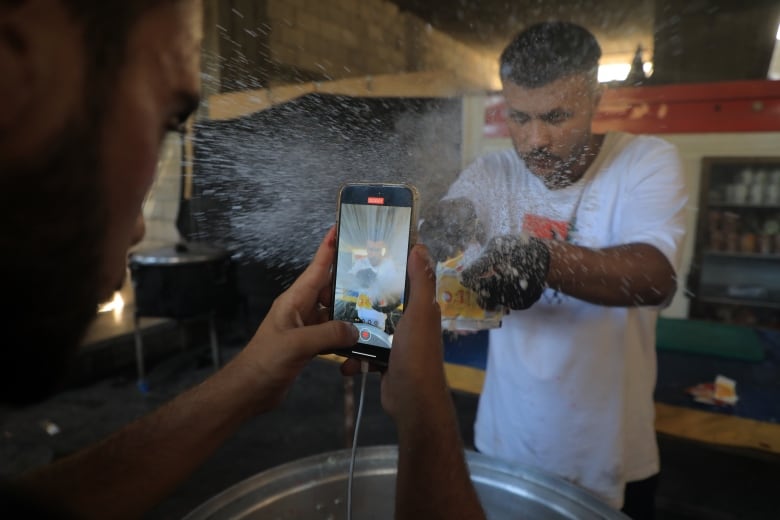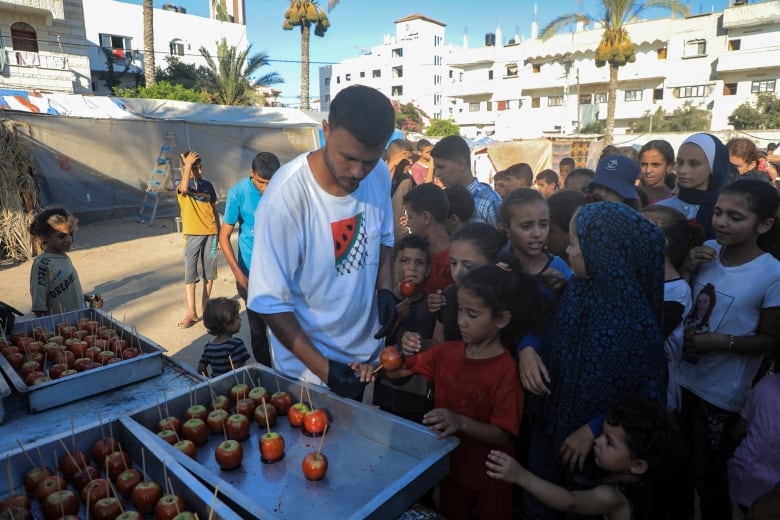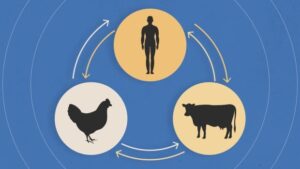
In Deir al-Balah in Gaza, Hamada Shaqoura makes his way to the market to scope out the options for the day’s social media video. Gunshots ring loud in the distance, but the 33-year-old doesn’t even flinch. The sounds of the war don’t affect him as much these days.
On this day, Shaqoura finds apples and reminisces about anbar, a dessert he used to get in Northern Gaza from a cart near the gates of his school, where the coloured candied apples were a staple. He gathers the apples and everything else he needs to create that glossy red coating around the fruit, and makes his way back to his makeshift kitchen.
“We’re trying to get as close to the taste as we can and make something delicious,” he tells CBC freelance videographer Mohamed El Saife. “To remind us of that taste and remind us of those days.”
‘This is the look of most of the people’
Before the war, Shaqoura was a food blogger and worked in social media marketing. His videos on TikTok and Instagram highlighted different restaurants in Gaza and reviewed their menu options. After the war began, Shaqoura didn’t want his passion to go to waste. So, using food he found in aid deliveries and in markets, he started posting videos of himself making meals out of what he could find, all while keeping a straight face to the camera throughout.
Shaqoura has since gained attention from around the world, with over 111,000 followers on TikTok and 475,000 on Instagram.

His infamous frown is a representation of how Palestinians in Gaza are feeling, he says, after so many months of war ravaging the strip.
“I suspect that this is the look of most of the people, the feeling of most of the people,” he said. “We’ve told the world in all languages, all that’s left is to speak to them with our eyes.”
Shaqoura returns to the warehouse out of which he cooks, and he and his friend begin filming. His friend behind the phone recording him counts him down. He pours the ingredients for the apples’ sugar coating into a large pot, his blue eyes locked into the phone camera in front of him. He mixes sugar and cornstarch with his hands before adding water. When he tries to squeeze a lemon with one hand, the juice squirts into his eyes, so he redoes the take a few times to get it exactly right — frown and all.
“There was a period of time in Gaza where there were a lot of restaurants — Mexican restaurants, Italian restaurants related to pizza and pastries, and Western restaurants,” he said. “And these are things that we as people, we miss eating.”
Reports of slow flow of aid in Gaza
Aid has been difficult to come by in Gaza since the war began on Oct. 7, when Hamas-led militants launched an attack on southern Israel that killed over 1,200 and took over 250 hostage, according to Israeli figures. Israel’s subsequent invasion of Gaza has killed over 39,000, by Palestinian counts.
The northern part of the Gaza Strip now faces a looming famine, according to reports from international organizations. Earlier this month, United Nations experts declared that “famine has spread across the entire Gaza Strip,” based on the number of children dying of malnutrition and hunger. Israel has denied that there is a famine in Gaza.
The report said the death of children from malnutrition and dehydration was indicative of the fact that health and social infrastructure has been “attacked and are critically weakened.”
There have also been reports that Israel is blocking aid from entering Gaza, including from U.K.-based Refugees International and from Philippe Lazzarini, the head of the UNRWA aid agency for Palestinian refugees.
In May, Scott Anderson of UNRWA said in a post on X that “no fuel or aid [had] entered into [Gaza] and this is disastrous for the humanitarian response.”
The Israel Defence Forces has denied such claims, and has blamed aid organizations for not properly co-ordinating aid delivery to civilians. It has also claimed that Hamas steals the aid and resells it to civilians at inflated prices.
During his address to U.S. Congress on Wednesday, Israeli Prime Minister Benjamin Netanyahu said the claims about Israel blocking aid were “utter and complete nonsense.”
Shaqoura said it is important to remember northern Gaza is suffering from famine, while he makes his videos in southern Gaza.
“If, God forbid, this aid was cut off, I wouldn’t be able to do anything and probably my work will stop.”
A welcome feast
Back in the warehouse, Shaqoura dips the apples and carefully places them on trays. He covers the trays and pushes the cart to the displacement camp, where kids crowd him as soon as they see him coming. They know exactly why he’s here.

The kids take their places in two lines, one for boys and one for girls, as Shaqoura gives each one a candied apple. Some are called aside to review the dessert for the video he’s filming.
Malak Abu Dawaba tells CBC’s El Saife that this is a welcome feast, after months of eating canned food.
“When we saw Uncle Hamada coming with desserts, we were so excited and happy,” she said, beaming with joy as she crunched into her apple.

